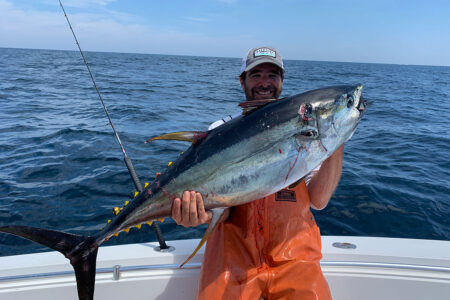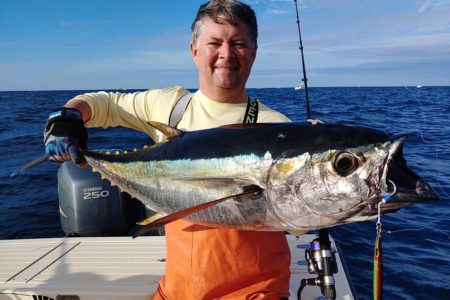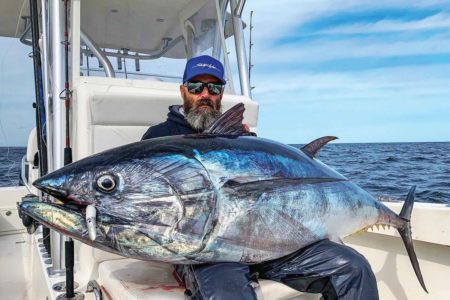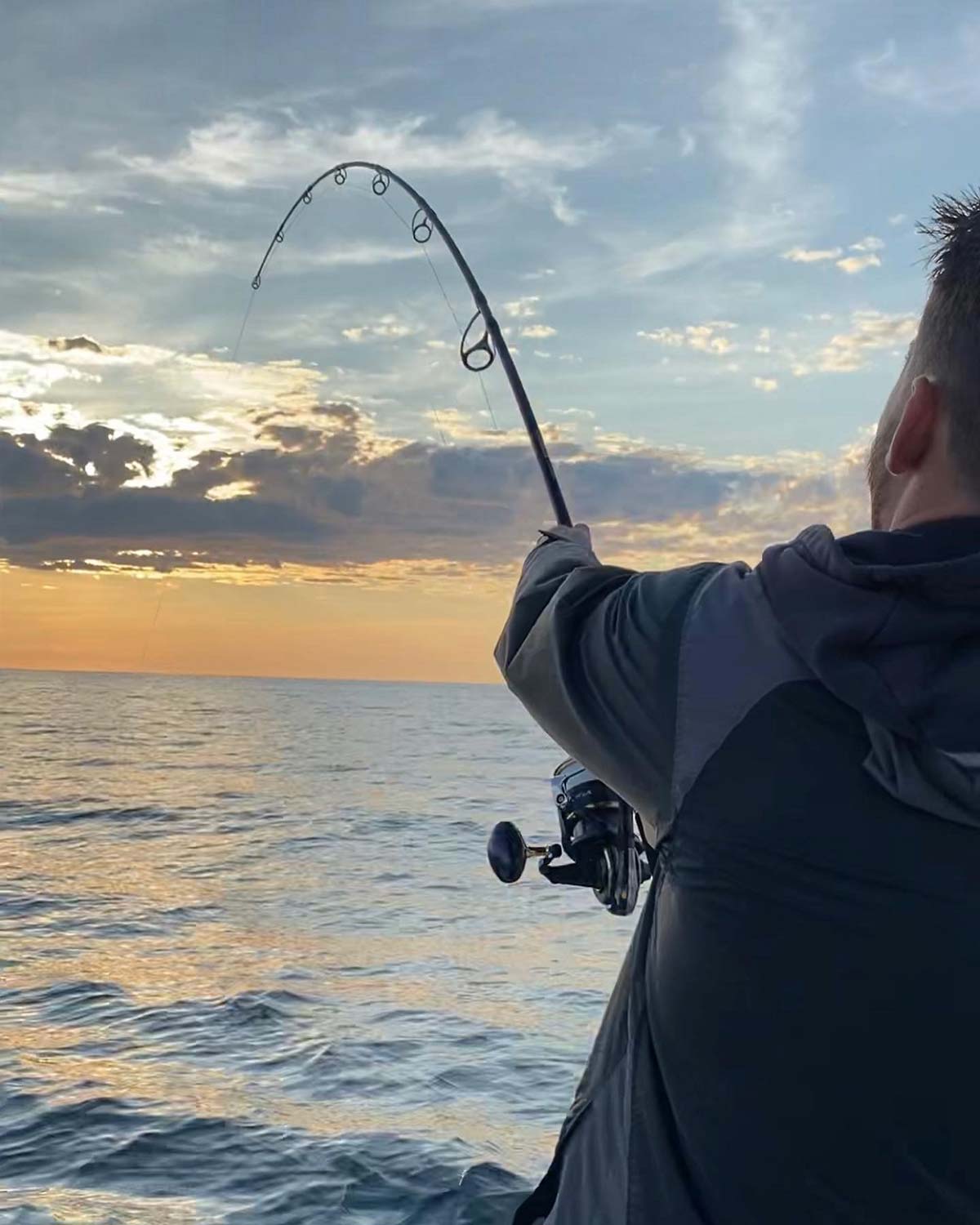
Winning a standup battle with a bluefin is a dance between captain, angler and a very powerful fish.
BUZZ-BUZZ-BUZZZZZ… it’s 2:30 a.m., the alarm is sounding and I am AMPED! It’s TUNA TIME!
If I’m being honest, I barely slept and yet, I jump out of bed like a little kid on Christmas morning. I immediately scroll to check the wind and wave forecasts to make sure there haven’t been any changes, everything looks good and it’s on! It’s still completely dark outside and most people are fast asleep, with maybe a few just getting home from a night out. Normal people would probably think I’m crazy, but I know better, I’m fully aware of that fact that I am a tuna junkie!
It’s mid-July, on Cape Cod and the weather is great, with calm winds, a big dome of high pressure and no fog! Still riding the rush of my previous outing a week ago, which was a great trip, the reports have told of incredible fishing in the seven days since. Anticipation is running high, but I’ve learned quickly, since becoming a full-time captain, that finding and catching are two completely different things. Especially when it comes to casting to bluefin tuna on spinning gear.
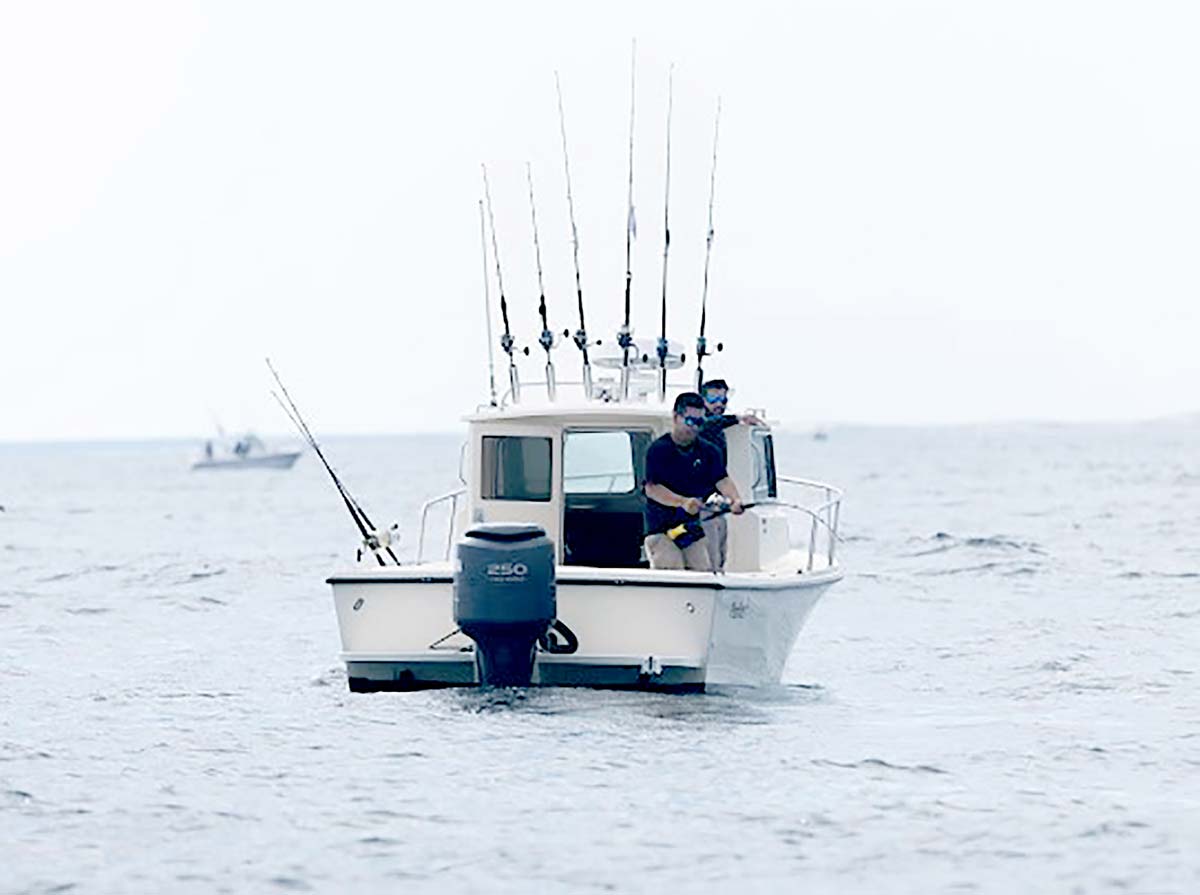
Timing The Light
At 3:30 a.m. we pull up to the ramp, still in full darkness, we conduct a quick, but thorough inspection of both vessels, all our safety gear, electronics and our trailers. After loading up, we pull away from the dock begin the hour ride to ‘tuna water’. I always ‘buddy boat’ when fishing offshore. It’s a big ocean and having two vessels allows you cover a much larger area and increases our chances of finding the fish. There’s also a safety component, if something were to go wrong, having another boat nearby can be a real lifesaver.
Right about the time we were rounding Race Point, the faint light of false dawn was starting to glow along the rim of the ocean and sky. As the light continued to swell, hundreds – if not thousands – of shearwaters could be seen all around us. We continued due east, with the glow of the impending sunrise just off the bow.
Being on the grounds before sunrise is essential to success. And as we arrived at our destination, mammal life was apparent all around us in the form of finback and humpback whales breaching and spouting in just about every direction. My confidence level was mounting, everything was in place and I was feeling like we were in the zone.
By 5 a.m. the sun is pretty much up for the day and everything seems to be staged perfectly with the amount of bird and mammal activity, not to mention, the clouds of sand eels on the screen, but I had yet to see a single tuna crack the surface and neither had my buddy boat. After a quick game plan “chat”, I went left and he went right. For the first 45 minutes of sunlight the action was slow. Then, finally, things turned on a dime.
Fish On!
Just before 6 a.m., while doing the “walk and gun” I spotted a solid group of about a dozen 80- to 120-pound class bluefin completely airmailing on a school of sand eels, and close to shore. Already in gear and moving, I quickly throttled up and put my client on scene. He made a perfect cast, like a quarterback leading a receiver, he splashed his Ron-Z just ahead of the school and began racing it along with the pod of charging tuna—he hooked up almost instantly. The fish dumped a couple-hundred yards of 80-pound braid in the blink of an eye!
When you hook a tuna, whether big or small, the initial run is usually out and horizontal from the angler, not vertical and deep, at least not during the early stages of battle. When my client first hooks up to a tuna on spin gear, I will usually let the fish make its initial run. This is actually the best time to put the “Cush It” on the butt of the rod, which allows the angler to fight the fish comfortably without a harness or fighting belt. Once the angler is stretched out, I will make any necessary adjustments with the boat in aiding my client, during battle. Basically, my goal is to keep the line away from the boat at all times and to make strategic moves that help my angler put as much pressure as he (safely) can during the battle.
As the battle goes on the fight will become more vertical. Once the fish is vertical with the boat, it will usually start to pinwheel. This is when the captain needs to be on his “A game”. I will usually put my client in the stern when this starts, either on the starboard or port side. Once the fight becomes vertical, it usually stays vertical until endgame as long as the captain does his job.
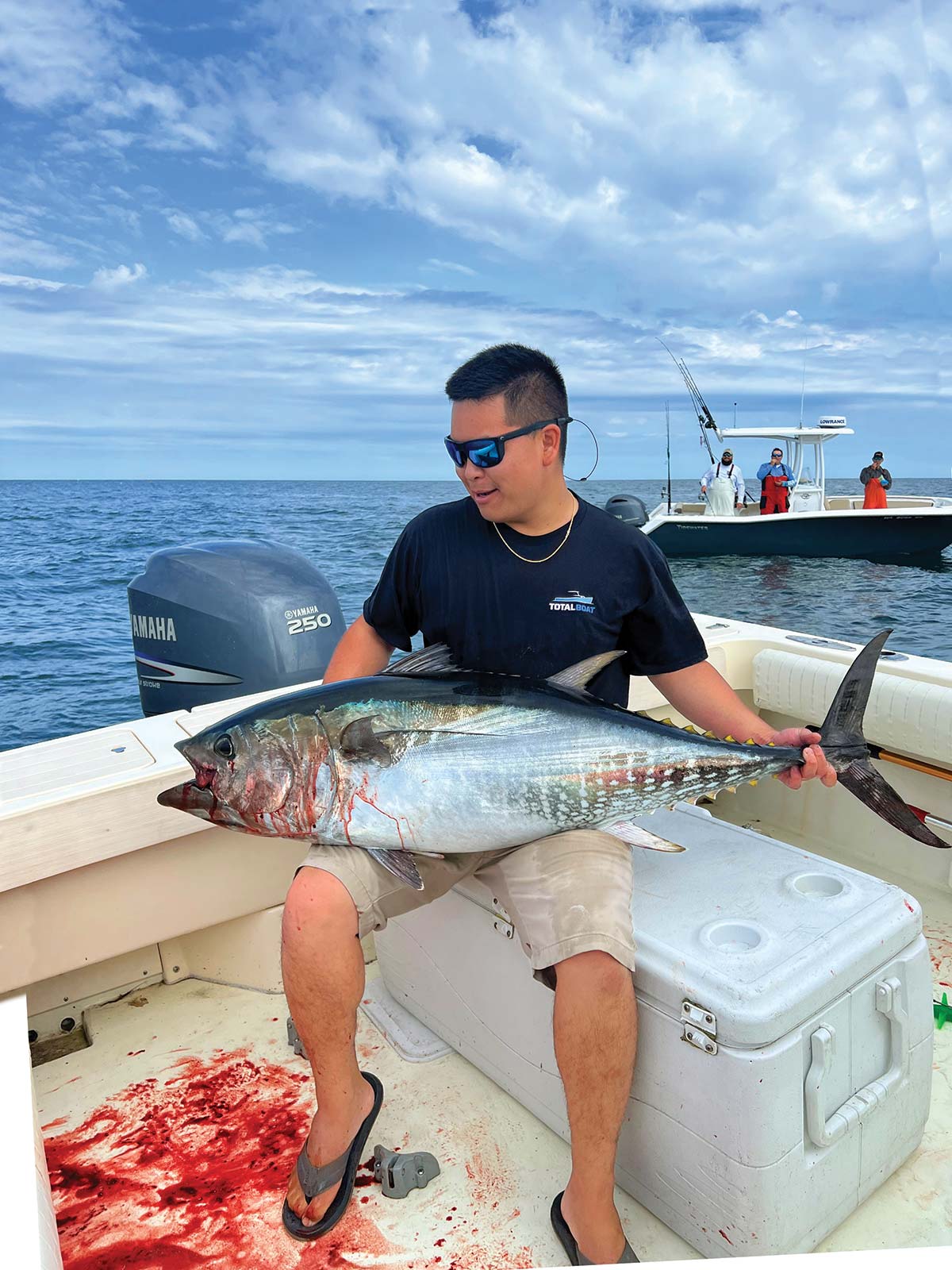
Endgame
As the fish pinwheels, I will slowly do circles with the vessel, keeping the fish off the desired corner, while making sure the line never touches the boat, trim tabs or motors. These are large pelagic fish that are every bit of 100 pounds, and they will test your strength to the core. That being said, it’s important to use everything you can to your advantage while battling these tuna on spin gear. I will make the necessary movements with the vessel to keep the line free of the boat to avoid losing the fish and to aid the client but only to a certain degree. Too much movement and you’ll actually be aiding the fish. Too little, and you will lose the fish. The goal is to make the fish fight the angler and the boat, when done correctly it will quickly tire the fish out.
I use my sonar during the fight to gauge how deep the fish is during battle. When I start to see color, this is when everyone has to be on their toes. When the fish gets close, it’s usually long after the initial hook up, so my clients are sometimes winded. It’s been a long battle for everyone involved so guiding the angler calmly (not screaming like some people do) is key to seeing it through to the end.
As the fish glides within range of a gaff shot, I will make sure it’s just the client and me in the chamber. It should be an open, clean and organized area. Finally, when the fish is close enough, I will try to make my gaff shot in the head, usually near the eye. I do this to ensure that the meat stays in good shape and to attempt to ‘stone’ the fish. Once the gaff is sunk and secure we’ll open the bail and I might ask my mate to sink a second gaff in the same general area to help me swing the fish onto the deck. Mission accomplished, but the job is still not finished.
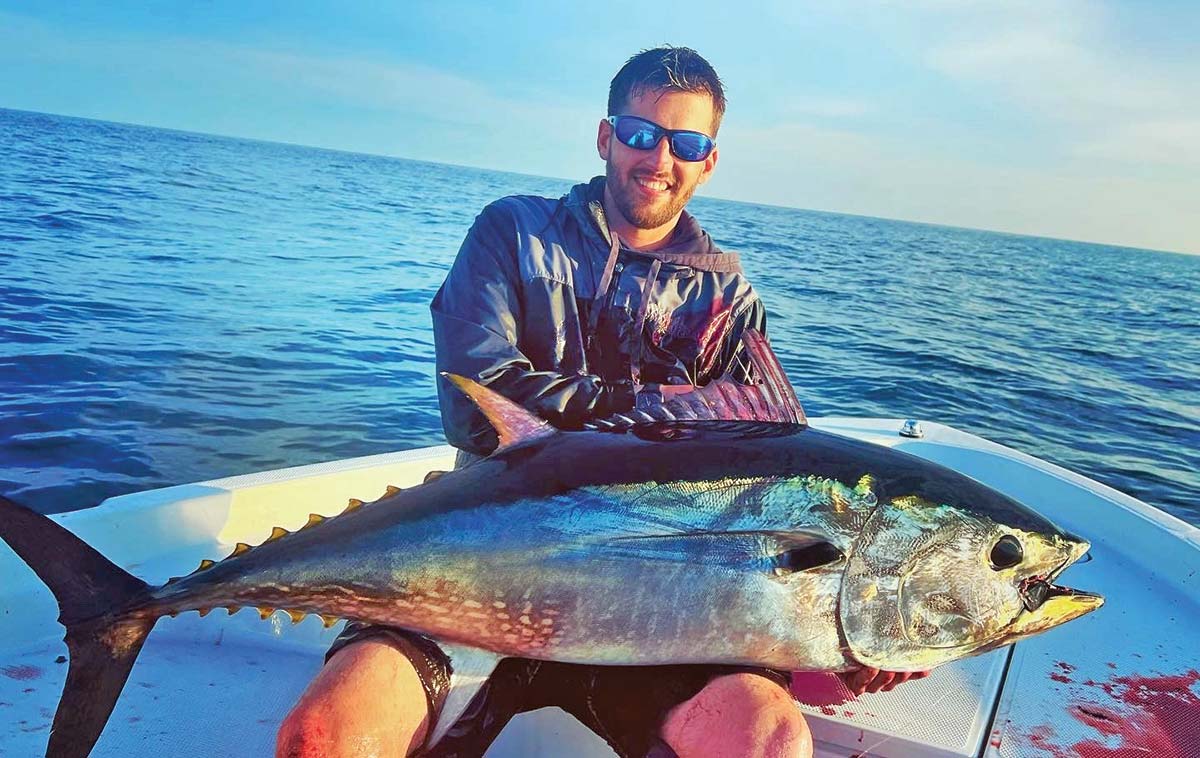
Taking Care
Now that the fish is on the boat, I will take a tuna grade filet knife and slice the fish once on each side behind the peck fins, loop a rope around the tail and hang over the fish over the side for about 15 minutes, while it fully bleeds out. Cutting the lateral blood line, behind the peck fins ensures the catch is properly bled.
I usually bring about 80 pounds of crushed ice onboard with me every trip. Once fully bled, it’s time to pack the fish full of ice and store it. First, I will take a strong serrated knife to cut off the gill plate, to give me access to the entrails. I will also core out the anus to remove the entrails I can’t get from the gills to ensure the fish has been totally gutted. When that’s done, I will pack the body cavity with crushed ice. I choose this method over “removing the head” because leaving the fish fully intact with ice packed inside of it, helps keep the ice cold and “snug” inside the cavity during storage. The last step is to load the tuna into the fish box. If the fish box is too small, I will cut off the head and/or tail. All of these steps are necessary for ensuring the best quality meat when this fish hits the plate.
If tuna fishing sounds like a lot of work, that’s because it is, but it’s also a ton of fun. This fishery consumes me every summer and there’s nothing like making it happen on spinning gear, try it and I’m pretty sure you’ll agree.

